Maria Montessori writes about the characteristics of her didactic materials as
- The principal quality of my material is to attract the attention of the child and to provoke a permanent reaction within the child.
- (The next quality) of my material is that it is systematic. All the objects are connected in a series and together form a material of development.
- (The third quality) of my material is that it contains (what I call) the control of error. As the child uses the material, the material shows the child his mistakes and, in this free path the child can correct these errors.
This also liberates him from unfavourable and discouraging criticism of others and develops in him the sense of (self-) criticism.
The California Lectures of Maria Montessori, 1915, p.11,12
The Montessori Materials are classified under five titles:
a. Practical Life:
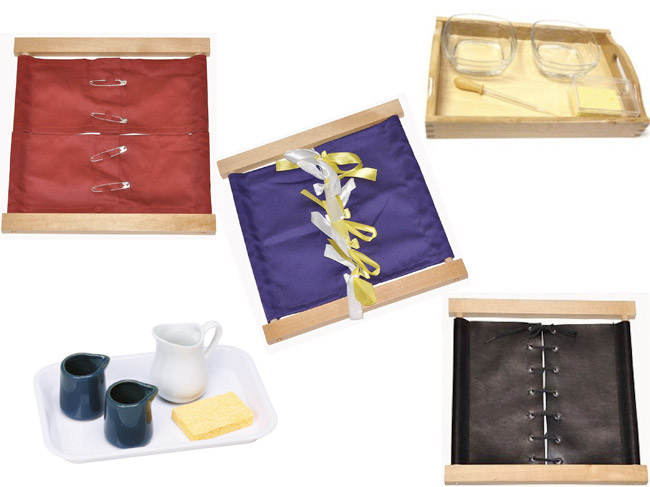
Practical Life studies are the type of activities where the child encounters as preliminary activities in a Montessori classroom. Practical Life materials provide a smooth transition between home and school for children. The tools used in the practical life materials are mostly household goods where children are familiar from their homes. Although, they are not allowed to touch those materials at home, they are encouraged to play –in Montessori’s terms ‘work’– with them in a Montessori environment. Therefore, practical life activities are very attractive for children.
It is very interesting that when children use real household goods in the classroom, they do not show any interest to play with the fake and toy like versions of those materials. In addition, using tools that are used in the real life situations are more meaningful for children, because mastering them is a key to their independence.
Practical Life activities serve, also, for another important purpose in the Montessori Method. Understandably, due to the reasons stated above, the child meets with the work cycle of Montessori for the first time in the practical life area. The child learns how to prepare a proper place to study (table or mat), how to choose a material and after his/her work finishes, he learns how to tidy up and place the material in its correct location.
While working with the practical life materials, the child’s
- Attention and concentration skills,
- Hand-eye coordination,
- Understanding of order,
- Self-control ability,
- Perception of independence develops and improves.
Practical life activities are
- Manual Skills: Pouring, sorting, threading beads, paper cutting, weaving and sewing buttons, and so on.
- Grace and courtesy: How to greet others, how to introduce yourself, how to shake hands and how to apologize and so on.
- Self-care: Cleaning your nose without disturbing the others, washing hands, dressing, buttoning, ribbon binding and so on.
- Care of The Environment: Ordering the shelves, dusting, caring for the plants and animals and so on.
b. Sensory Materials
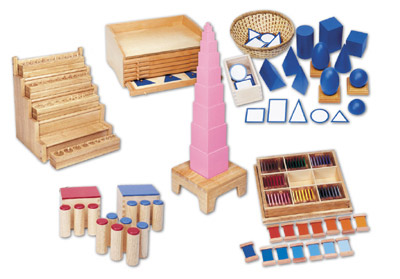
The purpose of these materials is to stimulate the child’s senses and to improve sensory perception from coarse to fine in order to increase their sensitivity. Children can work on their own or with a friend. The materials were designed to appeal to the child’s every sense aiming the most from each. The information about quality of objects such as dimension or color is defined to the child through the Montessori Materials. In the traditional education methods, these kind of concepts are presented by showing pictures or by using some random objects in the environment, but the Montessori Materials intelligently present these qualities in a concrete from and they form a complete curriculum which is lacked in traditional methods. Consider the Red Rods: it teaches long-short concept and grading the material from long to short and when the child is carrying and ordering the rods, his hands and even the whole body measures their length not only by the eye but also with the movement of the body in reference to his own dimensions. Of course, any child learns the concept of dimensions at last, whether they look at the pictures of long and short trees, buildings or people. The main difference of a child who learned these concepts at three will be the capacity of the brain that is to be developing. The brain resembles a perfect balloon, its volume will be limitless. So, you can blow it with a constant flow of air. The only limit is time; you have six years and you can start to blow any time. If you wait for four years, that will result in the loss of a capacity that could be obtained in four years.
Sensory Materials also prepares the child for the concept of number and builds a basis for the concept of area and volume.
c. Mathematical Materials
“It is almost possible to say that there is a mathematical relationship between the beauty of his surroundings and the activity of the child; he will make discoveries rather more voluntarily in a gracious setting than in an ugly one.”
Maria Montessori
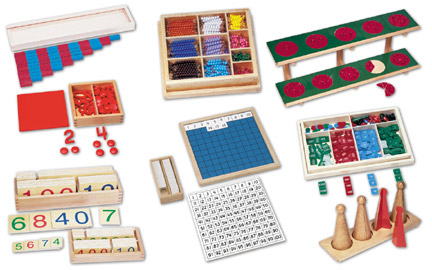
Mathematical Materials of the Montessori Method is a perfect evidence of Maria Montessori’s elegant genius. These materials are simple in design and the concept is easily delivered to the child’s mind. Children learn math as an enjoyable pursuit but not as a difficult subject. When children experience math in a comfortable and enjoyable way, there won’t be a reason to fear or to be anxious about math. One other important aspect of Mathematical Materials is their ability to lead the child towards success, as a result, the child’s attitude towards the concepts of math will be confident.
Mathematical Materials are always attractive for children. Because, when the child feels that he is successful this experience strengthens his confidence and develops continuous success.
Mathematics is completely an abstract knowledge; Montessori’s genius lies in her ability to design materials where this abstract form of knowledge is presented in a concrete form. The important thing is not the child’s correctness in operations, but his experience of the mechanism of mathematical concepts. Moreover, the control of error quality of the Montessori Materials shows the child whether his operations are correct or false. As a result, the child builds a positive attitude towards mathematics from the very early years of his life, which is an invaluable kind of experience.
Mathematical Materials are composed of information on numeracy, mathematical operations, geometry and other various mathematical concepts. An advance of the related concept presented in a material always follows a simpler one. Therefore, Montessori Materials, as a whole, accepted as a wall of bricks that built the mathematical knowledge piece by piece while establishing a perfect coherence between each concept. While working the materials children learn mathematics as hands on experience. The child begins with the concrete form of concepts and reaches an abstract understanding of mathematics. In traditional education, the child never experiences a mathematical concept in a concrete form. As a result, math education is delayed till six or seven, but in the Montessori Method children begin learning math at the age of two. When children come to age of six, they can process two or three digit operations and know about basic geometric concepts, fractions, they can read simple graphics and they have information about the concept of area and volume. Moreover, throughout the whole process, none of the children builds a negative perception towards mathematics.
d. Literacy
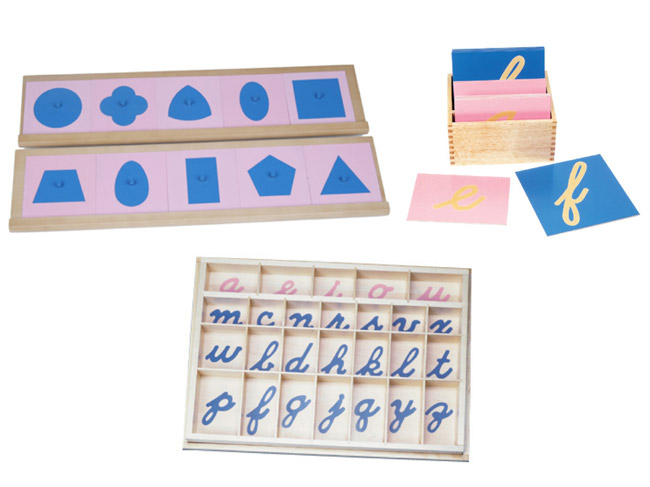
Language is the most important media for communication, self-expression and thinking. In the first year of their lives children learn hundreds of words, the rules of grammar of their mother tongue and correct pronunciation. The early years of life are very important to strengthen and expand the word stock of the child. Literacy area aims to teach the child how to use his language most efficiently.
First of all, children recognize the sounds that make up a language and after learning the sounds, they learn the symbols (letters) of those sounds. Reading is the process of sounding these symbols, but reading includes also understanding, therefore learning reading is a stepwise process. After learning to vocalize the symbols, the children are encouraged to learn how to give meaning what they have read.
Literacy for children is another world, such as math. Surprisingly, most of the time, you can see many kids preferring writing experience instead of playing with toys.
e. Cultural and Artistic Materials
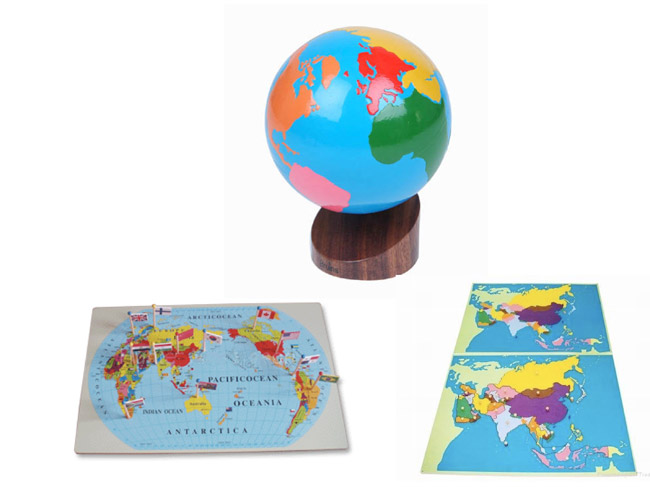
The materials of culture aims at learning about the Earth and promoting the diversity of every living being. This area is one of the most important areas in a Montessori classroom. Children learn about different cultures, different civilizations of history and most importantly, our responsibility to protect animals and nature.
Geography, history and biology allow the development of the child’s perception of his environment and the world. When creating the concept of the world, the child learns to think and behave with all the living beings in his mind.
For Montessori, art is an inseparable part of the culture area. Art is a form of language for self-expression with different possibilities. In this area, Montessori aims to show children different art forms and make them familiar with the language of art. The end product in an art activity is not the main aim but the art experience. Children are encouraged to live this experience to express their inner selves freely.
The child is introduced with the art of different cultures and artists. This gives a broad perspective of ideas about how other people interpret the world, life, or anything they want to express.
Experiencing art at an early age support children’s perception of beauty and aesthetic pleasures.
The characteristics of the Montessori Materials:
- Each set of material presents only one concept at a time. By that quality the concept is differentiated from all other stimulus to be isolated. So, the attention of the child is focused only on the aimed concept.
- Each set of tools has pieces, which show the maximum and minimum values of the concept that it intends to present. This quality is because the relative concepts can only be presented with the opposite.
- The tools are designed in such a way that will teach the concepts from the simple to complex and from concrete to abstract.
- Each material forms the basis for advanced concepts.
- One of the most important feature of the Montessori Materials is to have the control of error mechanism. Through this mechanism the child learns by herself, in other words she works with the material without help of an adult and can evaluate the result by herself.
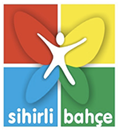

 Türkçe
Türkçe